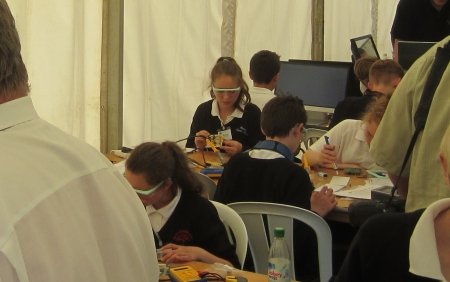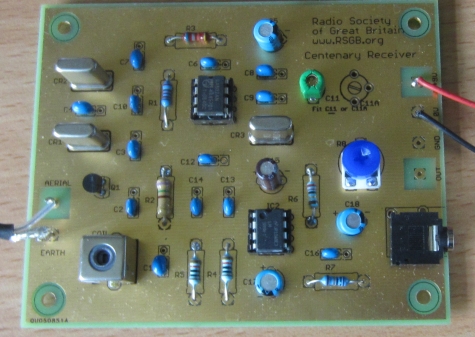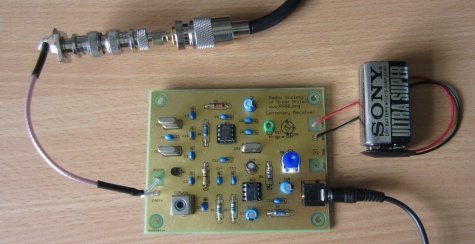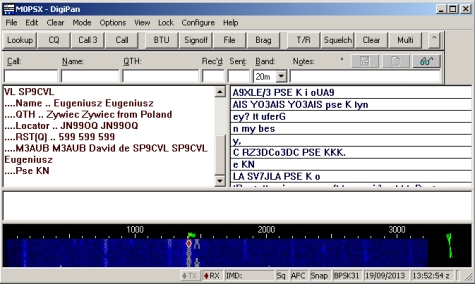As part of this year’s RSGB centenary celebrations, a PSK31 receiver kit was put together to help encourage kids to delve into construction. The kits were used by local schoolchildren at the RSGB Centenary Event at Bletchley Park in July. That kit is now available for constructors.

What is the project?
It’s a receiver capable of receiving PSK data signals on 20 metres. If you’re interested in construction, then this will allow to to build a low-cost 20m HF receiver, and connect it to a computer’s soundcard to use your computer to display received PSK31 data signals.
Constructing the project
The board and the instructions are available from the RSGB website. Price for the board, plus the 3 20m crystals needed is £6.79 to RSGB members, or £7.99 to non-members: RSGB PSK31 Kit at RSGB. Yopu’ll need to source the components, as these are not included in the RSGB kit, but you get the bits you need in kit form cheaply from Spectrum Communications.
Many thanks to David M0HBV, one of the training team at the Chelmsford Amateur Radio Society, for talking to us about the kit, and letting us have a try. According to David, this is a nice kit to build, and it’s very satisfying being able to put together an HF receiver this way. Here’s a picture of David’s finished board:

The board is pre-tuned to 14.070MHz, which is the 20m centre of activity for PSK31, although a 30pF variable capacitor allows for a small amount of frequency adjusting. The kit was originally designed to be used with a Raspberry Pi (the £25 credit-card sized computer board) using a USB soundcard, but as our Raspberry Pi’s being used for other things, we didn’t want to reconfigure it for use with PSK, so instead connected the audio output to the mic in on a laptop:

The kit gets power from a 9V battery and has a 3.5mm audio out for connection to a soundcard. Connecting to the HF antenna can be with a crocodile clip to the board’s antenna connector, but David’s soldered a BNC socket making for easy connection – Note our rather crazy series of adapters used to go from BNC to PL259 (the correct adapter’s gone missing!)
Once all was connected, we fired up Digipan, which is a freeware PSK application. Our normal PSK app of choice is Ham Radio Deluxe, which is overkill for simple PSK reception. Digipan, however, is a small an efficient free app which decoded signals from the board nicely.

Thanks to David for bringing the board to our attention. This could be particularly useful for someone looking to get into RF kit construction, and also to play with HF data reception without the cost of an expensive shop-bought HF transceiver.
You can find more information on the PSK Receiver Project in the September 2013 issue of Radcom, or using the links on the RSGB site: RSGB Radcom Downloads


Hi Pete, thank you for the recommendation of Spectrum Communications. I got in touch with them and they have two options for me. One just for the components and the other which includes a box, switches, etc. I went for the second option which including P&P cost me 24.50 GBP. Thanks again.. Paul.
Hi Pete,
I’ve recently tried assembling one of these neat little kits, but am having trouble getting it to work… I followed the instructions, and tested each stage as best I could with very limited equipment. The problem I’m having is when tuning the coil – I can hear the background hiss/noise increasing and changing pitch, but then all of a sudden the circuit seems to oscillate at an ear piercing volume. Like, painfully loud.
Just wondering if you have any idea’s as to what I may have done wrong or what to try to isolate the problem?
Many thanks in advance.
All the best,
Ben (in Australia)
The circuit is going into self oscillation. Make sure all parts are installed correctly and all leads are kept as short as possible.
the audio lead, from audio out to mic in on pc, is it a mono or stereo lead,does it make a difference.
thanks,
mark